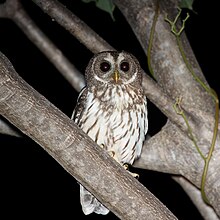Mottled Owl
| Mottled owl | |
|---|---|
 |
|
| Scientific classification | |
| Kingdom: | Animalia |
| Phylum: | Chordata |
| Class: | Aves |
| Order: | Strigiformes |
| Family: | Strigidae |
| Genus: | Strix |
| Species: | S. virgata |
| Binomial name | |
|
Strix virgata Cassin, 1849 |
|
| Synonyms | |
|
Ciccaba virgata |
|
Ciccaba virgata
The mottled owl (Strix virgata) is a medium-sized owl found in Central and South America from Mexico to Brazil and Argentina. The head and back are mottled brown and the underparts whitish, with vertical bars on the chest and throat. The eyes are dark and the head is round and they do not have ear tufts. They are territorial and found in dry forests and jungles up to 2,500 m (8,200 ft) above sea level.
The mottled owl was first described in 1849 by John Cassin as Ciccaba virgata. In 1999, Wink and Heidrich transferred it to the genus Strix, but this is still contested by some authorities.
The mottled owl is a medium-sized owl with adults reaching 280 to 355 mm (11.0 to 14.0 in) in length. Females are considerably larger than males; the mottled owl shows the greatest degree of sexual dimorphism of any species of owl. The crown, nape and back are mottled in several shades of darkish brown, the facial disc is pale brown and the throat, breast and belly are off-white with distinctive vertical brown streaks. The large eyes are brown, the beak is greyish-yellow or greyish-blue, and the legs and feet are greyish-yellow. There is a darker form of the bird with a buff breast and belly. Mottled owls produce a range of calls which include a hoot used in maintaining territory boundaries, and various whistles, screeches and hisses.
The mottled owl is native to Central and South America. Its range extends from Mexico south to Argentina and Brazil and it is found at elevations up to about 2,500 m (8,200 ft). It inhabits a variety of wooded habitats including rainforest, woodland verges, dry thorn forest, pine/oak woodland and plantations and also open countryside with scattered trees. In some parts of its range it is common and it is often found close to human habitations.
The mottled owl is nocturnal and spends the day in dense vegetation where it may be mobbed by other birds. Its large eyes are adapted for sight at low levels of light, and its hearing is also acute. It is a predator and at night often perches on a branch beside a glade or at the edge of woodland on the lookout for prey. When it detects a small moving object, it swoops down from its perch on silent wings and pounces on its target, which may be a small mammal, a bird, reptile or amphibian or a large beetle, grasshopper or other insect.
...
Wikipedia

